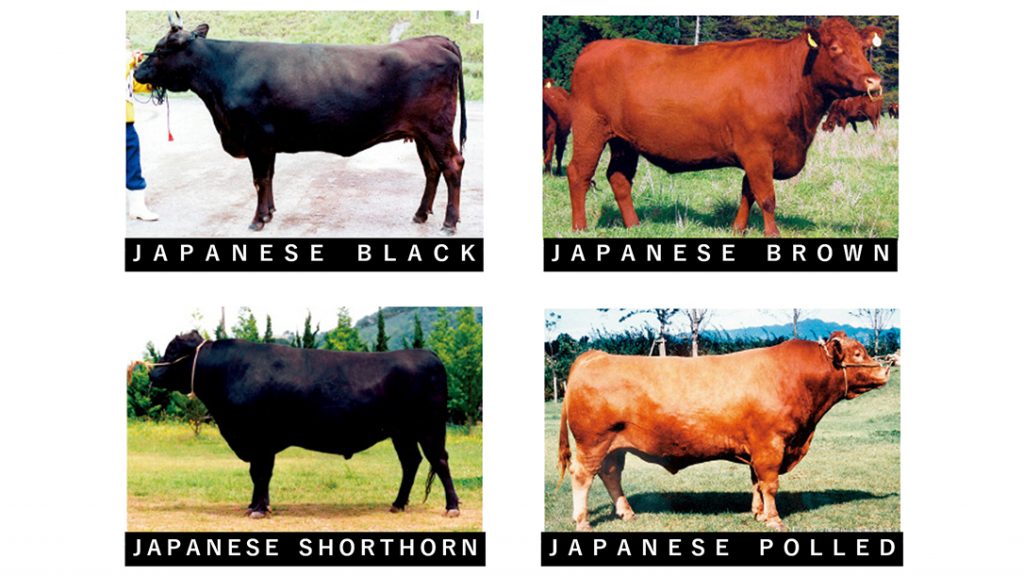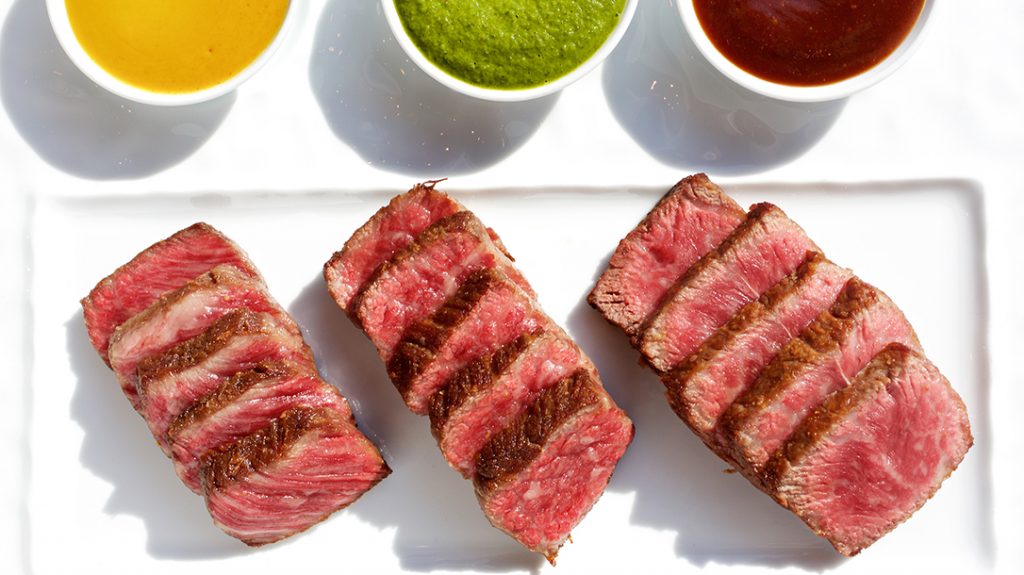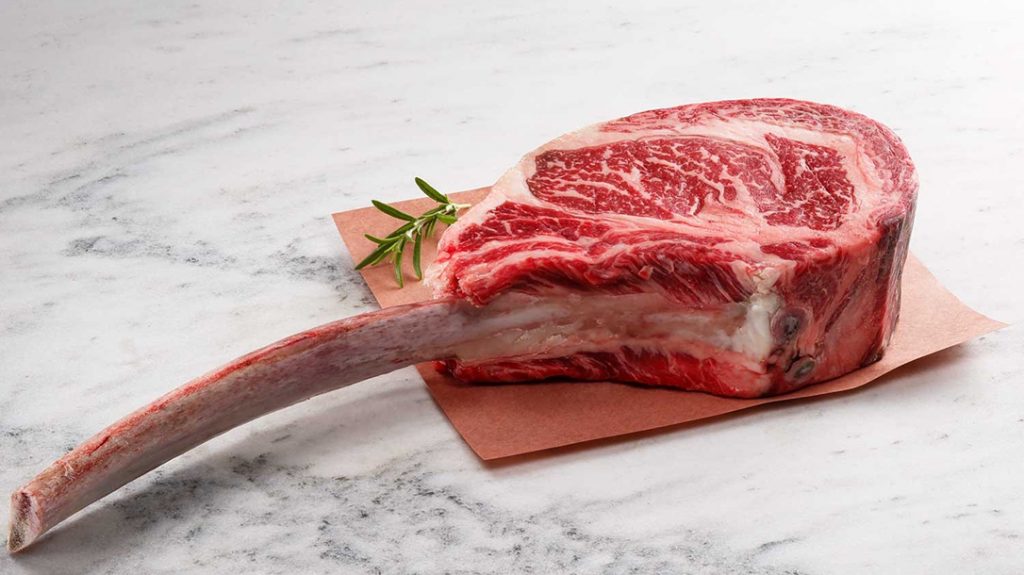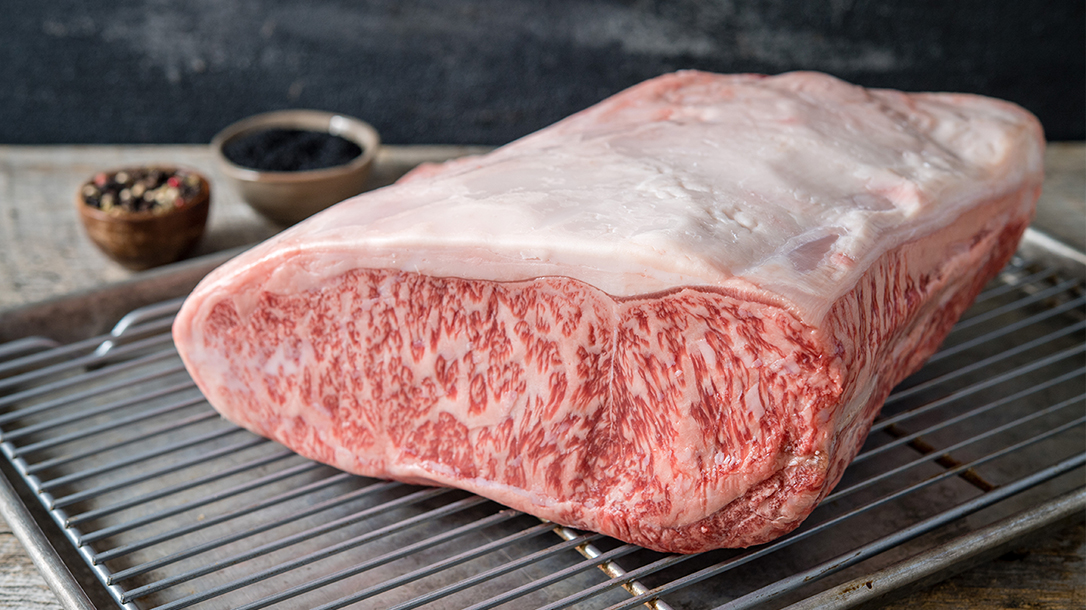Being a foodie of the first order, I found myself reading an article about Wagyu beef the other day. You know, those steaks that come from Japanese cows that are massaged every day and fed beer and sushi, all while being soothed by the strains of Mozart. Of course, I knew all of that was pure BS. But you must admit that such apocryphal rumors increase the demand and perpetuate the mystique of Wagyu.
In that article, the author used the familiar “melts in your mouth” cliché to describe the taste sensation of a top-grade Wagyu steak. What that triggered for me was the sudden recall of an old TV ad for M&M candy. The commercial claimed it “melts in your mouth, not in your hand.”
So what’s the connection? Well, I knew that an A5-grade Wagyu steak renders its intramuscular fat (marbling) at around 68 degrees Fahrenheit; that means that if you hold one in your hand, the heat from your hand will start melting the fat. The point is, Wagyu beef melts in your mouth and in your hand!
Advertisement — Continue Reading Below
Understanding Wagyu Beef
The more you research Japanese beef, the more confusing it can be thanks to many restaurateurs making false claims. We’ll get to that. But for now, let’s first make the distinction between Kobe and Wagyu beef. Of the two, Kobe has better name recognition here in America; that’s thanks to those colorful myths I mentioned and the fact that the Kobe breeders’ association is better at promotion. Kobe accounts for about 1 percent of all Wagyu produced in Japan, and Kobe is but one of 10 prefectures in the country where they raise Wagyu cattle. What must be understood is that, using an oft-quoted description, all Kobe beef is Wagyu, but not all Wagyu beef is Kobe.
All Wagyu comes from one of four breeds of cattle. Those include: Japanese Black, Brown, Polled and Shorthorn (I’ve Anglicized their Japanese names). Of the four, Japanese Black accounts for about 90 percent of all Wagyu. To qualify as Kobe, the animal must be from a castrated bull of the Tajima strain of the Japanese Black breed and born, raised, slaughtered and processed all within the Hyogo prefectureunder strictsupervision. Every carcass is government inspected, stamped and accompanied by official documentation tracing that specific animal’s ancestry going back a century or more and including its date of birth, weight, percentage of intramuscular fat (IMF) and maybe a record of how well he played with others.

Advertisement — Continue Reading Below
Only 3,000 or so cattle qualify as Kobe each year, and not all of them make the minimum Wagyu standard of A3 on the Japanese Beef Marbling Standard (BMS). An A3 rating means that the average cut of meat from that particular animal must have at least 21-percent IMF.
The Rare Factor
To put that into some perspective, consider that less than 2 percent of our domestic cattle qualify as Prime—the highest category on our USDA grading system. The Prime grade means that the various cuts from a specific animal must average 11 percent IMF, which is roughly half the entry-level standard for Wagyu. Contrast that with the fact that more than 50 percent of Wagyu meets our USDA Prime standard. We have to use the Japanese standard for Wagyu because our USDA grading system does not go nearly high enough. A Prime-plus steak on the USDA system, for example, would score about a 5 on the Japanese scale, which goes up to 12.
Like I said, Kobe accounts for about 1 percent of all Wagyu, and only 15 percent of that exports to the U.S. That translates to a mere 500 pounds per month for this entire country! In other words, it’s rare—so rare that only 21 restaurants in the country actually serve authentic Japanese Kobe beef, and half the time they’re sold out. And none of this beef is available at retail locations. But that doesn’t mean Kobe beef is somehow superior to A5 Wagyu. It’s not.
Advertisement — Continue Reading Below
Many experts prefer the firmer texture of an A5 steak from Miyazaki or Olive Wagyu. The latter are cows raised exclusively in Japan’s smallest prefecture, Kagawa, which includes Shodoshima Island, known for its olives. One enterprising Wagyu breeder, Masaki Ishii, figured out how to turn the detritus of olive oil processing into cattle feed. Olive Wagyu is the rarest form of Wagyu, as there are fewer than 2,000 cows in the entire Kagawa prefecture.
Grading
As for Kobe, it’s just different in that its breeders’ association requires a slightly higher IMF score of 10 out of 12 on the Japanese overall grade system; this means it must have a minimum of 52.9-percent IMF. Meanwhile, an IMF of 43.8 percent is the threshold for A5 certification. The A4 grade has IMF scores of 35.7 to 40.6 percent. Lastly, A3, the lowest Wagyu grade, spans 21.4- to 29.2-percent IMF. Again, to qualify for our USDA Prime grading, it needs only 11-percent IMF.
It’s worth noting that some A5 Wagyu scores 72-percent IMF! That means almost three-quarters of the steak is fat. And it’s good fat, believe it or not—the monounsaturated kind—and there’s more of it in Wagyu than in our beef.
Advertisement — Continue Reading Below
How Wagyu Beef Tastes
But enough of the jejune. We’re talking steak here. What matters is taste, not a bunch of clinical numbers. So what does Wagyu look like and how does it taste? Well, the most noticeable visual difference is the amount of marbling—the percentage of white fat (IMF) interspersed in the red meat. Whereas our USDA Prime steaks show isolated chunks of solid fat and relatively little marbling compared to even the minimum grade of A3 Wagyu, the higher the IMF, the more the steak takes on a pinkish appearance rather than red. Here, a picture is worth a thousand words.
As to the taste, the higher the IMF, the more the steak breaks down in your mouth. The consistency is nothing like what we’re familiar with. It’s almost like eating butter; that’s why it’s customarily served as an appetizer in Japan rather than an entree. I’m talking 2 to 4 ounces at most, often skewered and grilled tableside as small cubes or thinly sliced like carpaccio and served raw or flash seared.

Advertisement — Continue Reading Below
There are precious few sources of Japanese Wagyu here in America, but Crowd Cow is one of them. They deal directly with four different Wagyu breeders in Japan. There’s no middleman involved. The steaks they offer, including Olive Wagyu, are the real deal. Cost? Well, an 8-ounce A5 Wagyu filet from Kagoshima Farms in Japan goes for $100, a 13-ounce ribeye is $139, and an 11-pound rib roast is $1,055. Their Olive Wagyu is even pricier, but there’s a waiting list because it’s usually sold out. And these are retail prices, so restaurant prices are far higher. Consider this: At Wynn Las Vegas, one of those 21 restaurants that serve Japanese A5 Wagyu, prices range from $640 to $880 per pound!
American Standards
And this brings us to the other half of the Wagyu story: American Wagyu. Between 1976 and 1997, a few enterprising cattle ranchers brought some 200 full-blooded Japanese Black (Kuroge Washu) cattle here from Japan. However, in 1999, Japan initiated an export ban. Since then, no full-blooded Wagyu cattle have left that country.
Today’s domestic Wagyu population, then, is all descended from those 200 or so animals. Needless to say, each generation has been bred every which way from Sunday so that there are some 30,000 Wagyu-influenced cattle in the U.S. today, but according to the American Wagyu Association (AWA), only about 5,000 have been bred to retain their 100-percent-Wagyu DNA.
Advertisement — Continue Reading Below
Misleading Practices
The AWA has a grading system for domestic Wagyu. F1, the lowest grade, encompasses any animal that has up to 50-percent Wagyu as the result of crossbreeding. The USDA requires 46.9-percent Wagyu genetics for any beef sold at retail as “American Wagyu,” but restaurants have no such restriction. In fact, some are dishonest enough to advertise serving even the lowly F1 grade as “American Kobe,” which is totally misleading.
Unfortunately, there are hundreds of restaurants deceiving customers by using “Kobe” and “Wagyu” even in the descriptions of their hamburgers. But the sad truth is that as long as they have even a fraction of domestic Wagyu of any grade in their ground beef, they could call it a “Wagyu burger” and charge a rip-off price. The same is true with steaks. In fact, there have been several class-action lawsuits filed against some pretty famous high-end restaurants and chains for deceptive use of “Kobe” and “Wagyu” in advertising. Another surefire red flag is if you see a menu applying “Japanese Wagyu” to a porterhouse, T-bone or bone-in ribeye. Why? Because the only cuts imported from Japan are boneless. These cuts, however, are available with American Wagyu.
The American Way
Getting back to “our” Wagyu, the F2 grade requires 75-percent Wagyu genetics. Meanwhile, 87.5 percent is necessary for an F3 rating, which is the highest on the AWA’s crossbred scale. Animals that are 93.7-percent Wagyu qualify as Purebred. Lastly, a Fullblood rating means 100-percent Wagyu ancestry.
Advertisement — Continue Reading Below

As I already mentioned, there are currently fewer than 5,000 full-blooded Wagyu cattle in the U.S. One of the few sources is the Double 8 Cattle Company, which offers a 16- to 18-ounce Fullblood Wagyu bone-in ribeye dry-aged for 28 days for $83; the New York strip roast that averages 4.2 pounds goes for $259. When I checked these prices online, about a third of Double 8’s various steaks and roasts were either sold out or had fewer than six available. Do keep in mind that even our best dry-aged American Fullblood Wagyu falls far short of the 21-percent IMF threshold on the Japanese A3 overall quality scale. However, a 12- to 13-percent IMF steak ain’t exactly dog meat!
Is Wagyu Beef Worth It?
Which brings us to the obvious question: Is Wagyu—American or Japanese—worth the substantial extra cost? I guess it depends on your wallet, your curiosity and how much you appreciate a good steak. Fullblood American Wagyu will have roughly twice the IMF of a USDA Prime steak; as such, it’s going to be measurably better in both taste and tenderness. Moreover, it’s much more representative of what we Yanks expect a really good steak to look and taste like. Many who have tried both American and Japanese Wagyu actually prefer the firmer texture—bite resistance, if you will—of domestic Wagyu. To me, a steak can be too tender and too fatty. Even an A3 Japanese Wagyu steak has that “melt in your mouth” consistency, but it’s one that I expect from ice cream, not meat.
Advertisement — Continue Reading Below
Of course, you can’t make a fully informed decision unless you try Wagyu. It’s a different experience—one I highly recommend.
This article is from the June/July 2020 issue of Ballistic Magazine. Subscribe today at OutdoorGroupStore.com.






















